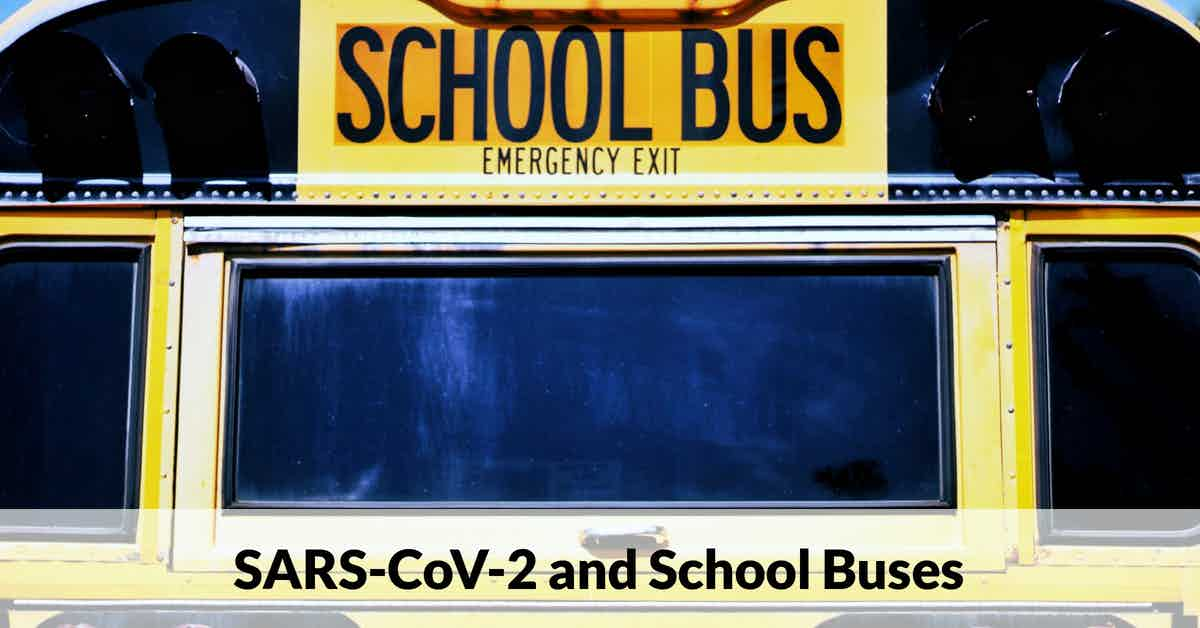Schools have been a focal point for the debate surrounding SARS-CoV-2 and the potential for transmission from students to teachers and faculty in the classroom and parents at home, with buses topping the list of areas of concern for multiple reasons.

Keeping School Buses Safe from SARS-CoV-2
According to the Safe Routes Partnership's National Statistics on School Transportation, as of the 2004-05 school year, the last year such information was compiled, approximately 55.3% of the students enrolled in the K-12 program--roughly 45,625,458 children--ride the bus to and from school each day.
Due to the increasingly restrictive mandates coming down from Sacramento, many schools that had planned to reopen were forced to close, but schools that had opened for in-class learning before the Governor's new restrictions were allowed to remain so, if under additional guidelines.
The fear surrounding this allowance was that children--largely unaffected by the COVID-19 illness--could act as carriers and transmit the disease from less restrictive home environments to teachers, faculty, and other students in the classroom.
Based on the available data, it is safe to assume that potentially half of the students going from home to school and back would be riding a bus, leading many to ask the obvious questions:
- What are the risks associated with school bus travel, and;
- What are the schools doing to mitigate those risks?
Risks Associated With School Bus Travel
On average, school buses in the U.S. can carry approximately 72 students, with the typical one-way trip coming in roughly 30 minutes.
Presently, it is believed the primary route of transmission for SARS-CoV-2 is via contaminated droplets expelled from one person to another in close proximity to each other for a protracted period of time.
The second most common method is via contaminated surface to person transmission--touching a contaminated surface and then your face, mouth, eyes, or nose.
That's where the challenges begin.
Children do not rank highly on any hand hygiene compliance study and, expecting each of them to adhere to strict mask-wearing guidelines, let alone hand awareness recommendations (not touching the seat, rails, or window and then fiddling with their mask or rubbing their nose or eyes) is likely obtuse, at best.
When combined, the general environment plus the primary routes of transmission appear to make bus transit extremely problematic, if not highly undesirable.
Unfortunately, alternative methods of transportation are not feasible for many families.
So, how do we make the buses safer for students and help prevent the transmission of pathogens to teachers in the classroom and parents at home?
Mitigating Risks Associated With School Bus Travel
Mitigating the risks involves some challenging management solutions on the part of districts.
The first step is eliminating the number of students on the bus--something that may or may not pose a challenge, given the number of schools forced to remain closed due to the governor's strict mandates.
Reducing the number of students on the bus allows for more space between the riders and reduces the potential for exposure to airborne pathogens.
The next step is to shorten the length of the ride, which, again, may or may not pose a serious challenge for each district and the areas they serve, especially more rural neighborhoods and districts, which suffer from notoriously long transits to and from school.
Another commonly cited recommendation is to, where the weather allows, keep the windows open to help naturally dissipate the airborne pathogens.
This recommendation is followed closely by not running the AC/heater with the windows closed to prevent contaminated air circulation throughout the bus.
The final recommendation is to maintain high cleanliness and hygiene standards on the bus by implementing consistent enhanced cleaning and disinfection services.
Clearly, cleaning the inside of a bus at the end of every shift would require the services of a small army who, regardless of the best of efforts, would ultimately miss numerous surfaces and unnecessarily expose themselves and the riders to dangerous pathogens and deadly disinfectant products.
A superior and proven alternative to employing large numbers of workers to spray and wipe down a bus every day is to outsource electrostatic disinfection services to a trained professional service provider.
References & Resources
- National Statistics on School Transportation
- School bus safety during the COVID-19 pandemic: 8 recommendations
- The Rural School Bus Ride in Five States
- School buses adapt to keep kids safe during COVID-19 crisis
- Can school buses safely transport children during coronavirus pandemic?
Takeaway
Despite obvious challenges and well-founded concerns, travel via bus by school-aged students does appear to be safe.
However, the potential for the spread of pathogens to teachers and family members is high if the buses are not well maintained and cleaned daily to a very high standard.
Keeping up with the cleaning and disinfection requirements can be expensive and dangerous when left to inexperienced drivers or other district employees.
Outsourcing is a proven method for ensuring the highest standards of cleanliness and safety are adhered to, especially in challenging environments occupied by vulnerable demographics.
If you would like more information regarding the effectiveness of high-performance infection prevention and control measures, or if you would like to schedule a free, no-obligation onsite assessment of your facility's custodial needs, contact us today for a free quote!
In Bakersfield CA, call (661) 437-3253
In Fresno CA, call (559) 206-1059
In Valencia CA, or Santa Clarita CA, call (661) 437-3253
In Palmdale CA, or Lancaster CA, call (661) 371-4756

